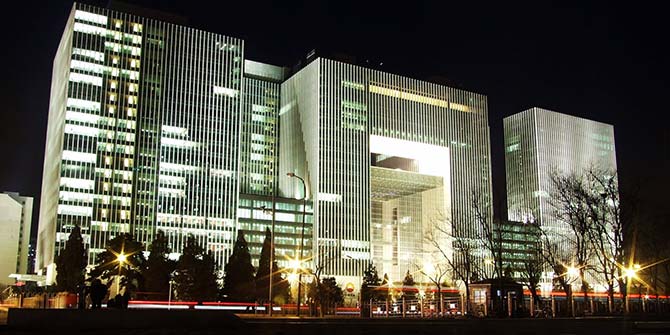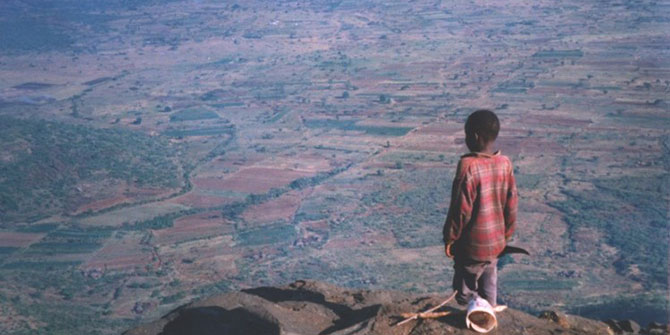Carolin Dieterle investigates the how, when and where of large-scale land investments in Uganda.
This article is part of the #PublicAuthority blog series, part of the ESRC-funded Centre for Public Authority and International Development.
In the last decade since the financial and food price crisis of 2007/08, large tracts of land across the developing world, especially in Africa, have been acquired by domestic and foreign investors for the development of commercial agriculture, forestry projects, infrastructure, and oil and gas exploration. Uganda, in particular, has received a considerable influx of foreign large-scale land investments, which are strongly promoted by the Ugandan government under their Vision 2040 development strategy. According to the Land Matrix Observatory, an online database on global land investments, there are currently 17 registered large-scale land investments across Uganda.
Large-scale land investments are often understood and promoted by governments and international development organisations as ‘win-win’ scenarios and as drivers of ‘inclusive growth’. According to this view, investment projects contribute to development and poverty reduction through increased job opportunities, the expansion of infrastructure, and the transfer of technologies. In addition, the World Bank, various UN organisations as well as national development agencies have developed an array of ‘best practice’ standards and (voluntary) guidelines for large-scale agricultural investments. These are based on the principle of ‘inclusive growth’, with the aim of guiding investors in setting up socially and environmentally sustainable projects that allow the reaping of economic benefits.
However, there is relatively little knowledge about how, when, and where such ‘win-win’ situations are created in practice, and about the actors and processes involved in shaping these land investments. As multi-scaled phenomena, large-scale land investments may involve various stakeholders at various levels, such as host government agencies (i.e. state actors wielding public authority at national and local levels), local and traditional authorities (i.e. customary chiefs, clan leaders, elders, who also act as public authorities), investors and farm managers, civil society groups (including international and local NGOs, farmer associations etc.), local communities, and international donors. There is considerable potential for conflict.
My PhD project aims to analyse the various processes (i.e. land allocation, land transfer, negotiations, local consultations etc.) and the roles, interests, and actions of diverse actors and diverse forms of public authority around land investments in Uganda, at multiple levels. I will examine how these actors and stakeholders interact, what shapes their relationships, and how different public actors contribute to these processes. In particular, this project aims to scrutinise how these interactions and relationships between actors vary across space, from project to project, within the Ugandan context, and what effect this may have for the prospects of ‘win-win’ situations and the shaping of public authority around land. From the premise that land investments hold the potential to drive development in the context of inclusive growth and ‘win-win’ scenarios, how and under what conditions is such inclusive growth negotiated from international, national to local levels by various actors?
So far, I have observed that:
Large-scale investment projects in Uganda are embedded in a lively debate on whether they help or hinder development. This is not least highlighted by the recent controversy around the proposed amendment to Article 26 of the Ugandan Constitution. The amendment bill would effectively allow the government to force the sale of land for the purpose of government infrastructure and investment projects, the argument being that such projects are delayed due to land disputes and refusal of sale. While some argue that the expropriation of land owners for the sake of development is justified, others see this as a threat to fundamental rights of Ugandan citizens.

Fuelling this debate, large-scale investment projects across Uganda are highly diverse. While some investments have been successful and expanded over the years, others have erupted in much publicised local conflict and were forced to stall or abandon their operations. Investment projects also differ by sector, with most projects involved in sugarcane, coffee, tea, and other agricultural commodities, forestry, oil and gas, or infrastructure. This sectoral variation determines some of the structural differences between investments. For example, sugarcane, tea and coffee plantations usually involve higher numbers of hired plantation workers as well as smallholder contract farmers whereas forestry projects and investments for the purpose of oil exploration usually depend less on the involvement of local farmers. What is less obvious, however, is that these investment projects also present vastly different scenarios regarding the forms of public authority involved, conflict dynamics and claims on land rights by local communities, and the way that investments are regulated.

Image Credit: Carolin Dieterle
Mainstream literature usually outlines three actor groups involved in large-scale land acquisitions: the host country government as the public authority, the investor as the outsider, and local communities as the threatened citizens. My findings show that in Uganda, claims of authority over land go far beyond these three categories. In particular, the role of public authority around land investments is often misunderstood. The Centre for Public Authority and International Development (CPAID) understands “public authority” to include social institutions that exist beyond the immediate family and exercise a degree of voluntary compliance. In line with this, public authority around land investments is not only represented by a range of diverse actors, but also varies from context to context and across space.
For one, the central state in land investments is not present as one homogenous official public authority. Several government bodies have different interests, roles and mandates around land investments. For example, the Ugandan Investment authority (UIA) carries the mandate to promote and facilitate private sector investment in Uganda, as stipulated in the 1991 Investment Code Act. The National Forest Authority (NFA) is responsible for managing Central Forest Reserves, owned by the central state. Several of these reserves have been leased out to private investors for the development of pine and eucalyptus plantations. Further, the National Environmental Management Authority (NEMA) oversees social and environmental impact assessments of planned investments and manages the preservations of wetlands, river banks and lake shores. Several investment projects in Uganda cover areas that include forests, wetlands and/or lakeshores, thereby creating questions about authority relations between different government agencies. In addition, the President himself has at times become personally involved in legislative matters around land investments, such as personally granting land rights to affected communities.
Another form of public authority over land in Uganda comes from the five traditional kingdoms active in present-day Uganda, namely the Buganda, Bunyoro, Busoga, Toro and Ankole Kingdoms. These kingdoms historically controlled substantial parts of land across the country before they were abolished, and their land placed under central government control in 1967. After President Museveni reinstated the kingdoms in 1992 as cultural (not political) institutions, some of this land was returned (unequally) to the kingdoms. However, tensions over historical claims and rightful ownership of land between the central government and the kingdoms still remain unresolved today. Some large investment projects in Uganda cover land that is (partially) claimed by a kingdom, leading to questions over ownership and authority.

Image Credit: Carolin Dietele
At the local level, local leaders and community-based activist groups act as public authorities around land investments. To varying extents, local leaders are involved in negotiations around land acquisitions concerning the basis of land rights of communities, the terms and conditions of resettlement, and compensation payments. In several cases, local land users have (successfully) resisted the acquisition of their land for the purpose of large-scale investment projects. Such local resistance can be organised by individual activists, or by lawyers and community leaders such as chiefs and elders. Communities are also often supported and organised by international and local NGOs.
Civil society groups and NGOs play an important role in supporting communities in disputes around land investments. For example, international NGOs such as Action Aid, Oxfam, and Transparency International have been involved in some cases of large-scale land acquisition across Uganda, where they provided legal support during court cases, supported local communities in negotiations with the investor and the government, and guided land users in exercising (peaceful) resistance. International and national NGOs exert public authority for communities in the way that they disseminate information about planned investments, educate land users about their land and human rights and how to defend these, and provide access to grievance mechanisms. In addition, these NGOs can act as ‘watchdogs’ by publishing reports about investment cases that can scale up to the global level and can threaten the reputation of investors.
In sum, considering the variety of actors around land investments as outlined above challenges our understanding of public authority around investment projects and shows the complexity of these multi-scaled phenomena. Continuing my research, I hope to analyse in more detail the different contexts (i.e. regional differences, land tenure variations, historic factors) that determine the diverse ways that investment projects unfold across Uganda.
Read more about #PublicAuthority and visit our website.
Carolin Dieterle is a doctoral researcher in LSE’s Department of International Development.
The views expressed in this post are those of the author and in no way reflect those of the Africa at LSE blog, the Firoz Lalji Centre for Africa or the London School of Economics and Political Science.






Hello
As someone who has worked in both developed country (USA) planning and international water governance, I find the concerns of participatory and accountable government processes of great interest, generally.
I am a bit confused about the exact focus of the research, however.
-Are you focused on situations where it is public land being developed or where there is some private ownership of some sort (even informal tenure/usufruct, etc)?
-Also, is the research centered on rural, urban, or suburban land development?
-Is there a type of development that is a focus?
If it is a broad, country-wide thesis, is the focus on the forced selling of private land? In many countries, there is something called “Eminent Domain”, a rarely used, but powerful way of forcing the sale of private property in a small subset of cases. How does this play out in Uganda?